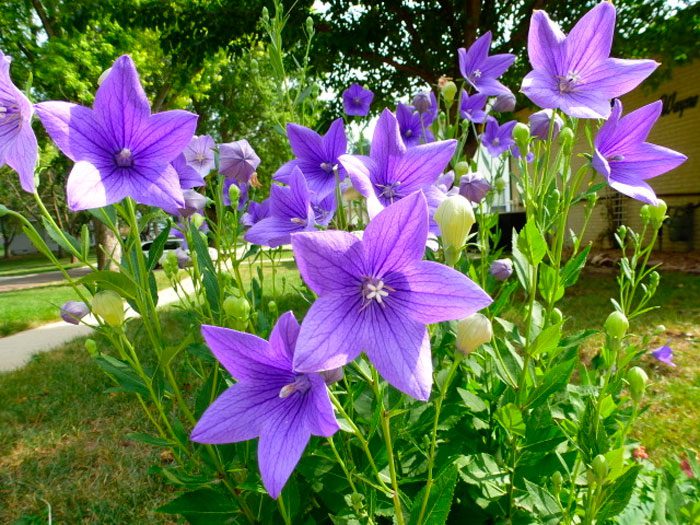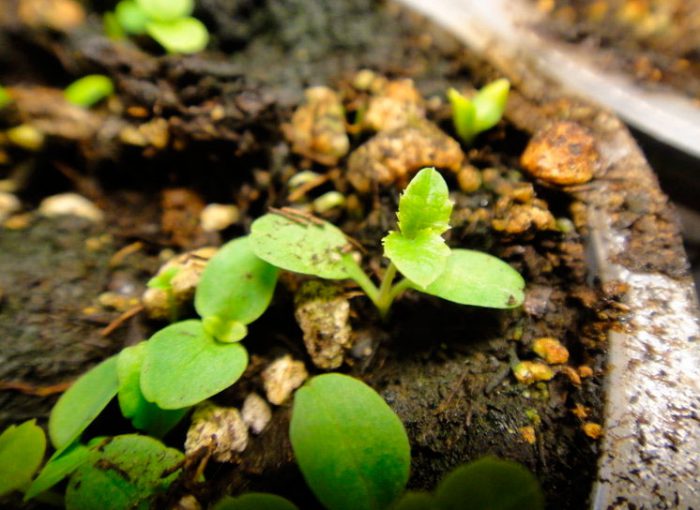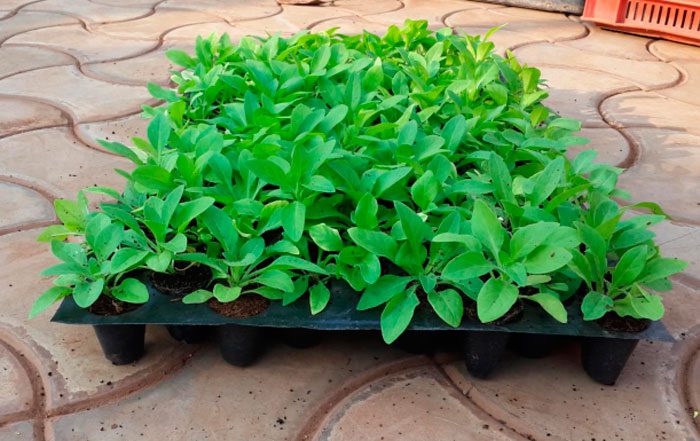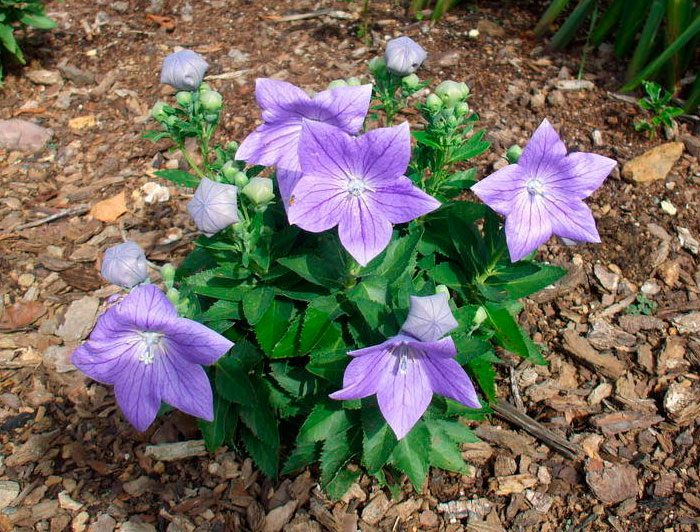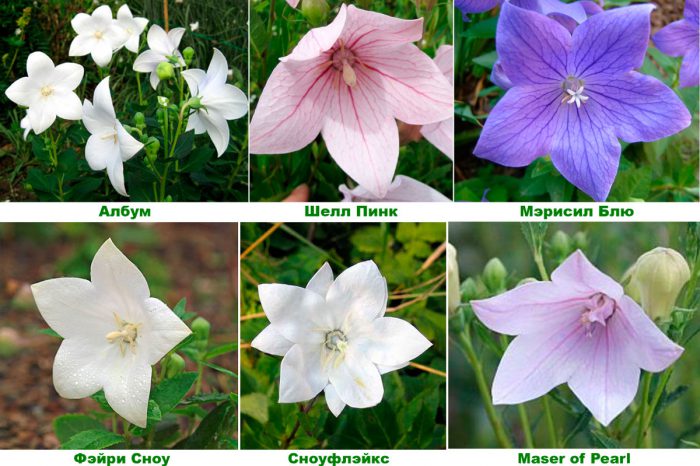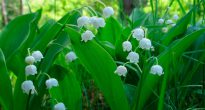Such a herbaceous perennial plant as Platycodon, also called shirokokolokolchikom, is a member of the bellflower family. The flowers of these plants look like large, wide bells. In nature, they can often be found in Eastern Siberia, China, the Far East, as well as in Korea and Japan. Platycodons prefer to grow on forest edges, rocky slopes and forest glades. The name of such a plant comes from the Greek language, and it consists of the words "platys" - "wide, even" and "kodon" - "bell". This genus is monotypic, because it includes only 1 species - Platycodon grandiflorus, or large-flowered bellflower (sometimes confused with broadleaf bellflower). This species has been cultivated since 1872, but this flower gained popularity among gardeners only at the beginning of the 20th century.
Content
Features of Platicodon
Platycodon's rhizome is fleshy, and the height of its straight, thin, densely leafy shoots can vary from 0.2 to 0.8 m. Opposite leaf plates have an elongated narrow or ovoid shape, as well as a finely toothed edge. The leaves located below are part of the root rosette. Leaf plates and shoots have a light bluish tint. Flowers can be single or 3-5 pieces collected in panicle inflorescences. The wide-open flowers are rather large, they can reach 8 centimeters in diameter, on the surface of the blue petals, a network is clearly visible, consisting of thin veins of dark color. There are forms, the color of the flowers in which can be white or dark purple. The outwardly swollen buds of such a plant are very similar to lanterns. Flowering lasts about 8 weeks and begins in the second half of July. The fruit is an egg-shaped capsule containing glossy flat egg-shaped seeds. It is recommended to grow such a flower in the garden together with a tall bell, gypsophila or undersized phlox.
Growing Platicodone from seeds
Sowing
Very often, gardeners choose the generative (seed) method for reproduction of Platycodon. Seeds can be sown directly into open soil in spring or before winter, but experts advise growing such a plant through seedlings.Sowing seeds for seedlings is recommended to be done in the last days of February or the first days in March. Before starting sowing, the seeds must be prepared. To do this, they are poured into a bag of gauze and placed in a not very large vessel filled with water, where they must stay for two days. For sowing seeds, it is recommended to use large flowerpots or boxes, which must be filled with an earth mixture consisting of humus, peat soil and sand (1: 1: 1). The substrate must be well loosened, and then Platicodon seeds are laid out on its surface. There are 2 different opinions about embedding the seed in the ground, so, some of the gardeners claim that it is not necessary to bury the seeds, while the rest say that they need to be sprinkled with a thin layer of sand (thickness from 0.3 to 0.5 cm). When sowing is finished, the substrate should be moistened with water at room temperature using a sprayer. Cover the container on top with a film, and then transfer it to a warm place (from 20 to 22 degrees). It is necessary to water the crops only after the top layer of the substrate dries up. The first seedlings should appear 7-15 days after sowing.
How to care for seedlings
It is necessary to care for the growing seedlings of Platycodon in exactly the same way as for the seedlings of other garden flowers. When the first seedlings appear, the shelter must be removed, while the container itself is rearranged to a cooler place (from 18 to 20 degrees). Seedlings should be watered only when necessary. After each watering, be sure to very carefully loosen the soil in the container. After the seedlings have 3 or 4 true leaves, they will need to be picked into individual pots with a diameter of about 10 centimeters. Flowers will grow in these containers until they are planted.
Planting Platicodon in open ground
What time to plant
Platycodon seedlings should be planted in open soil in the last days of May or the first in June, when you are sure that the night frosts are over. For such a plant, it is recommended to choose a sunny area in the garden, but it can also grow and develop normally in partial shade. The soil should be not too wet, well-drained, loose and rich in nutrients. Loam with a low sand content and a neutral reaction is best suited for such a flower. In an adult bush, the root system is located vertically, in this regard, the groundwater at the site must necessarily lie deep enough. It should also be noted that Platycodon cannot be transplanted because its roots are very fragile. It can be grown in the same place for more than 10 years. Before planting seedlings, the site must be dug up, while adding fertilizer to the soil, so 1 large spoonful of complex mineral fertilizer and 0.5 tbsp are taken per 1 square meter. wood ash.
Landing features
The size of the holes should only slightly exceed the volume of the seedling pots. The distance between them should be from 25 to 30 centimeters. Before planting, the plant must be watered abundantly. There are gardeners who recommend immersing the plant completely in water along with the pot before planting. Then the seedlings are carefully removed from the pot, and an earthen lump is lowered into the prepared hole, which is then covered with soil and compacted a little. The planted plants need watering.
Platycodon care in the garden
Newly planted seedlings in open soil need systematic watering. It must be carried out every day for the first 14 days. Then the plants are watered no more than 1 time in three days and not so much water is poured onto one bush. When the platycodon is watered, it is necessary to loosen the surface of the soil and pull out all the weeds. To reduce the number of watering, weeding and loosening of the soil, it is recommended to cover it with a layer of mulch.
Also, this plant should be systematically fed once every 4 weeks with a complex fertilizer for flowering plants. These flowers have one feature, namely, they stretch up strongly, this becomes clearly noticeable after the bush turns 3 years old. In order to preserve the decorativeness of flowers, it is recommended that they regularly make pinches, or they can be treated in spring with a special preparation that slows down the growth of the plant (inhibitor), for example, you can use the Athlete. In the event that the platycodons are still strongly elongated, they will need to be tied to a support. You also need to remove in time flowers that have begun to fade.
Reproduction of platycodon
It is best and most reliable to propagate such a plant in a generative (seed) way. Some gardeners try to propagate Platycodon by cuttings, but only a few can do this. But if there is a desire, then of course, you can try to grow such a flower from cuttings. Cuttings are harvested in spring, for this it is necessary to cut off the stem process with a pair of internodes, as well as with the heel. Then the cutting is planted for rooting as usual.
If the bush is grown on sandy soil, then for its reproduction, you can resort to dividing the bush. To do this, carefully dig up the flower, and then make a thorough inspection. If you find shoots with buds, then they can be carefully cut off with a pre-sterilized sharp knife. Places of cuts should be treated with sulfur or ash, and then the cuttings should be planted in a permanent place in open soil. However, when propagating Platycodone vegetatively, you should be prepared for the fact that you will fail. The best and easiest way to grow this plant is from seeds.
Diseases and pests
This plant is very resistant to a variety of diseases. However, if the weather is very wet for a long time, then there is a high probability of infection of Platicodone with gray rot. In order to avoid this, experts advise to thoroughly loosen the surface of the soil, as well as to be extremely careful with watering, try to avoid stagnation of moisture in the root system of the plant. If the flowers have already begun to rot, then it is recommended to dig up and destroy the affected bushes, and the remaining ones must be sprayed with a solution of copper sulfate or Fundazol (2%) or Topsin-M (1%). After 1.5 weeks, it is recommended to spray the plants again.
Only rodents, or rather, moles and mice, can harm such a flower. They are able to injure his root system. There are a large number of methods that will help get rid of these pests, but which ones are suitable in your case, it's up to you. The most effective way is to "smoke" the rodents out of their houses. To do this, you need to connect a rubber hose to the exhaust outlet of your chainsaw. The other end of this hose should be placed in the burrow. While the chainsaw is working, smoke will begin to enter the hole, and the rodents will get to the surface. There is another way to get rid of pests. You will need to purchase bait with poisoned cereals and spread it around the site. It should be borne in mind that this method of controlling rodents does not work on moles.
Platicodon after flowering
Seed collection
When the box inside the flower cracks, it will be possible to understand that the seeds are ripe. Seeds are collected only after the pedicels are completely dry (usually in September). Absolutely new varieties can grow from seeds collected with their own hands, while the flowers of such plants will have an unusual color.
Preparation for wintering
This flower is a perennial.In this regard, in autumn, its above-ground part must be completely cut off, and the surface of the site must be covered with a thick layer of mulch (humus, dried foliage, peat, sawdust or spruce branches).
Platycodon varieties with photos and names
As mentioned above, the Platycodon has only one species, but there are a great many different varieties. Most popular varieties:
- Album... A fairly common variety with erect shoots, the height of which can vary from 0.6 to 0.8 m. The diameter of white large flowers is 8 centimeters, while their surface can be streaked with thin veins of blue. Flowering is observed from the last days of June to August.
- Shell Pink... Plant height is about 0.8 m, and large flowers are colored light pink.
- Marisil Blue... The height of the compact plant does not exceed 0.35 m. The blue flowers have a spectacular lavender hue.
- Fairy Snow... The height of the plant is about 0.8 m. Single flowers are very delicate, they are painted in light lilac or white and have thin veins of blue.
- Epoiema... Plant height does not exceed 0.2 m. The color of the flowers is blue-violet. Recommended for growing in rock gardens and rockeries.
- Snowflakes... On a bush of half a meter in height, semi-double flowers of white color flaunt.
- Mather of Pearl... The height of the bushes is about 0.6 m. The color of the flowers is pale pink.
Sometimes gardeners decorate their garden with such a flower as the Ussuri codonopsis (codonopsis means "like a bell"). This plant is closely related to Platycodon, but its aroma is very sharp and unpleasant, which is why it is not very popular with gardeners.


